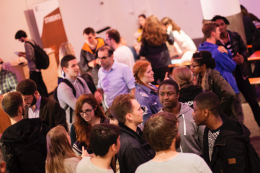 Steve Boon, Executive Pastor of Emmanuel Church, Brighton, and I have speaking about some of the characteristics and benefits of a multi-site church. Now we will consider some of the cultural issues.
Steve Boon, Executive Pastor of Emmanuel Church, Brighton, and I have speaking about some of the characteristics and benefits of a multi-site church. Now we will consider some of the cultural issues.
Nigel: I think one of the points you made earlier is that ‘multi-site’ reduces the amount of travel and so makes church meetings more accessible to those living close to that particular venue. There is quite a variety to the social profile of the different populations across the Brighton and Hove conurbation. How is that worked out within an individual site?
Steve: That’s a really good question. The average age of our church when we did a survey a few years ago was roughly 38. I think we fairly resemble the city in terms of census and age groupings. Brighton has two universities and various colleges so it has quite a young, educated feel to it with a large population with degrees and quite a large number living on their own.
 Where the sites are located tends to pull in the demographics from that area. Only one of our venues, or one of our eight services to make it even more pertinent, is an evening service in the centre of the city, and that particularly suits youth, young 20’s and undergraduates.
Where the sites are located tends to pull in the demographics from that area. Only one of our venues, or one of our eight services to make it even more pertinent, is an evening service in the centre of the city, and that particularly suits youth, young 20’s and undergraduates.
Another of the benefits of multi-site is that you can experiment at one service. Then what we learn can be applied in others. So the ability to be creative and innovative is massive. That’s one really exciting element to our model. It gets the best out of some people who love to innovate and push us on. For example, the guys who lead the evening service moved it out of the main hall for a season into what we call the Lounge. They also multiplied the number of services in the evening and changed the times, which is easier to do when you don’t have an entire church to communicate to. So you can see our site leaders have tremendous scope to innovate whilst being served with a central team working to a shared common vision and purpose.
Nigel: What about the economic profile? For instance in the east of Brighton there is lower priced housing, estate-type accommodation, so presumably the people are generally poorer.
Steve: I’m so glad you asked that question because I wouldn’t have thought to mention this. It certainly applies for the site led by Stephen and Emma Dawson who moved to that part of the City maybe 10 years ago. When they moved they were gradually joined by 20-30 couples and young families over a period of a few years. They served that community and ultimately planted a site there. Yet interestingly we have found consistently that they are one of the most generous sites we have. It’s been really lovely to see a site serve so faithfully and the impact they are having in their local areas is evident year on year.
Nigel: I am impressed that you always seem to have the facts at your finger-tips!
Steve: Yes, I enjoy tracking data, trends and possible projections so that true facts can be found, not just impressions. I believe that is important.
Nigel: Does the predominance of one socio-economic group affect the way a Sunday service is run and its dynamics? For instance what about the length of the preaching? Some of the people going to that site may not have a very high educational level and be leading life through the week in different ways and with different traditions. Do you have any comments on that?
Steve: The site leader is able to plan their service in a way that fits with their local demographic. However you just don’t know what’s going in sometimes when people are sitting on the seat or participating. Also, the involvement at site level in small groups is important and is touching about 80% so whatever we do at site level is serving those that come on Sundays regardless of the length of the preach or service.
Next time we will look at some more of the benefits and disadvantages of a multi-site church.
